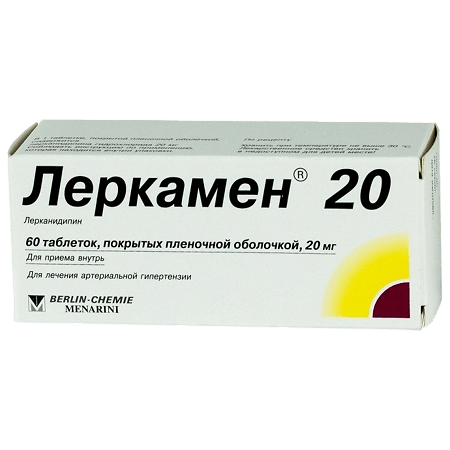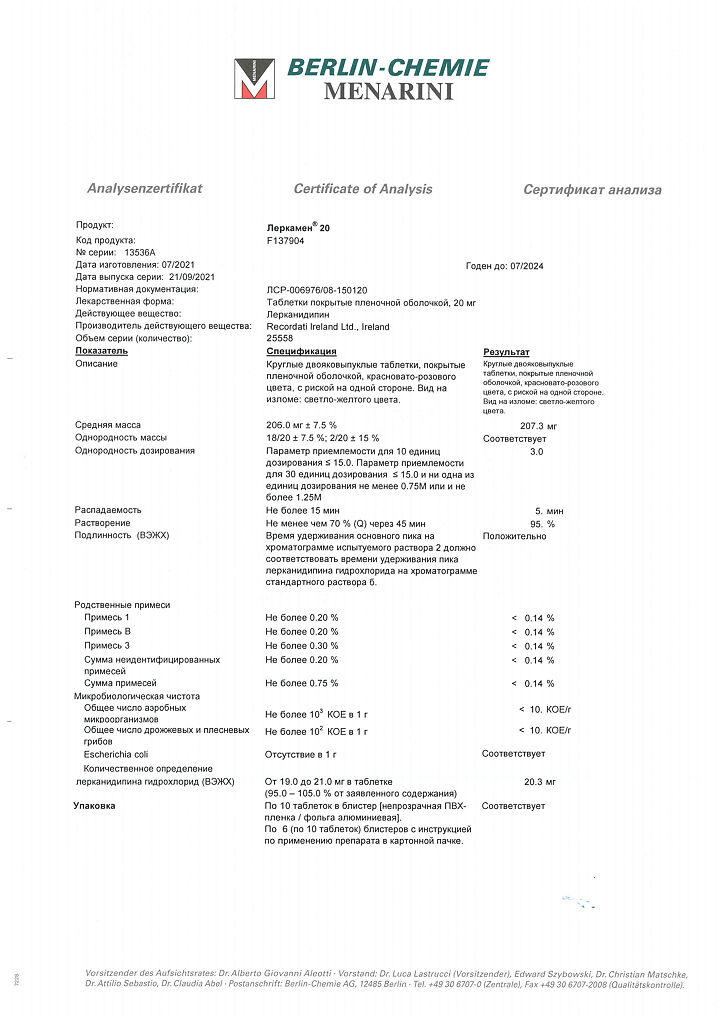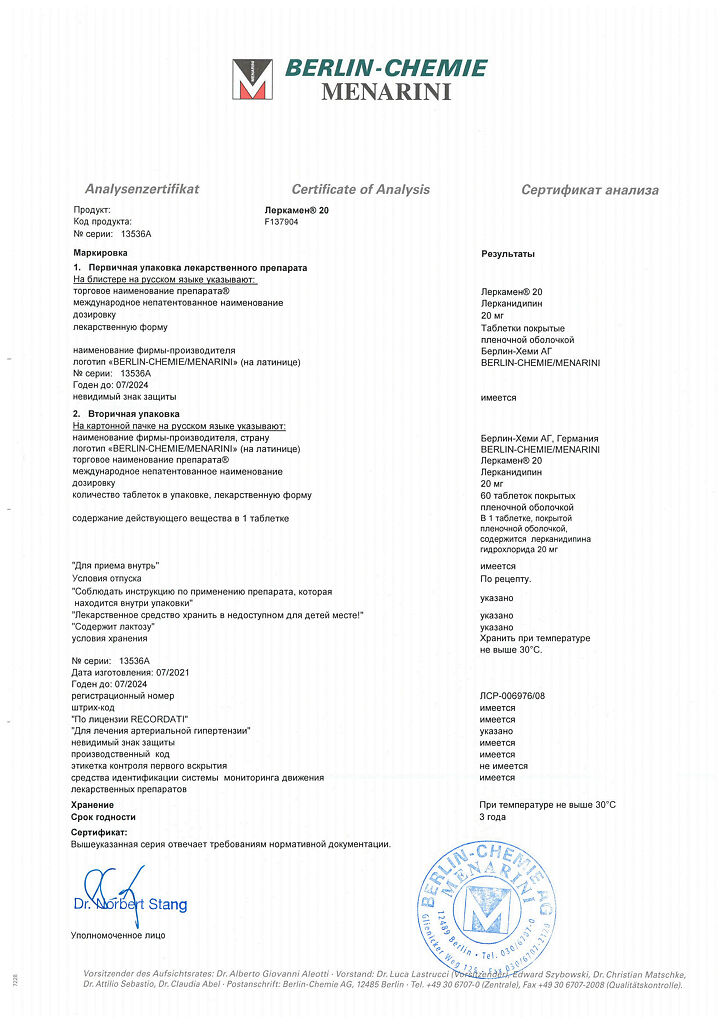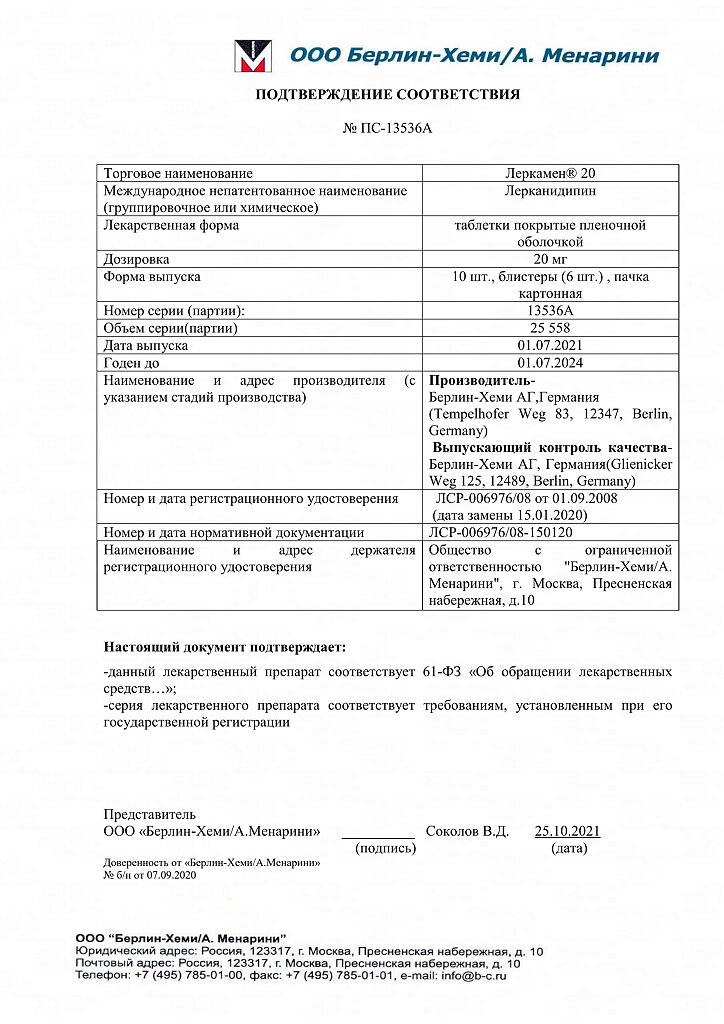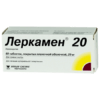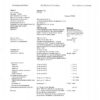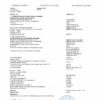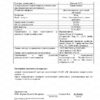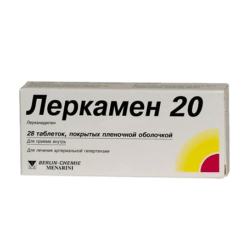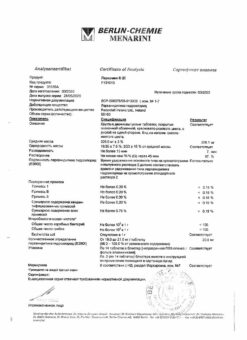No products in the cart.
Lercamen 20,20 mg 60 pcs
€39.96 €33.30
Description
Pharmacodynamics
A selective slow calcium channel blocker with predominant effect on blood vessels, dihydropyridine derivative. Inhibits the transmembrane flow of calcium ions into vascular smooth muscle cells. The mechanism of antihypertensive action of lercanidipine is due to a direct relaxant effect on vascular smooth muscle cells, resulting in reduction of RPS.
In spite of relatively short plasma elimination half-life, lercanidipine has prolonged antihypertensive effect due to high membrane distribution coefficient. Due to high vascular selectivity, it has no negative inotropic effect. Acute arterial hypotension with reflex tachycardia occurs rarely due to the gradual development of vasodilation when taking lercanidipine.
Lercanidipine is a racemic mixture of (+)R- and (-)S-enantiomers. The antihypertensive effect of lercanidipine is primarily due to the S-enantiomer.
The duration of therapeutic action is 24 h.
Pharmacokinetics
Intake
Lercanidipine is completely absorbed after oral administration. Cmax in plasma is reached after 1.5-3 hours and is 3.3±2.09 ng/mL and 7.66±5.90 ng/mL after administration of 10 and 20 mg of lercanidipine, respectively.
The (+)R- and (-)S-enantiomers of lercanidipine demonstrate a similar pharmacokinetic profile: they have the same time to reach Cmax, the same T1/2; the Cmax and AUC values are 1.2 times higher for the (-)S-enantiomer. No interconversion of enantiomers was observed in in vivo experiments.
Because of the “first pass-through” effect through the liver, the absolute bioavailability of lercanidipine is approximately 10% when taken orally after a meal; the bioavailability decreases by 1/3 when taken on an empty stomach. When taking lercanidipine within 2 hours after a fatty meal its bioavailability increases 4 times, therefore the drug Lercamen® should not be taken after meal. During oral administration of lercanidipine its plasma concentration is not directly proportional to the dose taken (nonlinear kinetics). The saturation of presystemic metabolism, occurs gradually. Thus, bioavailability increases with increasing dose.
Distribution
Distribution from plasma to tissues and organs is rapid and extensive. Binding to plasma proteins exceeds 98%.
Metabolism and excretion
Lercanidipine is metabolized with participation of CYP3A4 isoenzyme to form inactive metabolites.
About 50% of the dose taken is excreted by the kidneys (about 50% is excreted in the intestine). Elimination occurs mainly by biotransformation. The average T1/2 is 8-10 hours.
Cumulation of lercanidipine is not observed with repeated oral administration.
Pharmacokinetics in special clinical cases
. The pharmacokinetics of lercanidipine in elderly patients, patients with renal impairment (CK greater than 30 mL/min), and patients with mild to moderate hepatic impairment have been shown to be similar to those observed in the general patient population.
In patients with renal impairment (CKR less than 30 mL/min) and in patients on hemodialysis, plasma concentrations of lercanidipine were higher (approximately 70%).
In patients with severe renal and/or hepatic impairment, due to decreased plasma protein concentrations, the free fraction of lercanidipine may increase.
In patients with moderate to severe hepatic impairment, the systemic bioavailability of lercanidipine is likely increased because lercanidipine is metabolized primarily in the liver.
Indications
Indications
Essential hypertension of I-II severity.
Pharmacological effect
Pharmacological effect
Pharmacodynamics
Selective blocker of slow calcium channels with a predominant effect on blood vessels, a dihydropyridine derivative. Inhibits the transmembrane flow of calcium ions into vascular smooth muscle cells. The mechanism of the antihypertensive effect of lercanidipine is due to a direct relaxing effect on vascular smooth muscle cells, resulting in a decrease in peripheral vascular resistance.
Despite the relatively short plasma half-life, lercanidipine has a prolonged antihypertensive effect due to its high membrane distribution coefficient. Due to its high vascular selectivity, it does not have a negative inotropic effect. Acute arterial hypotension with reflex tachycardia occurs rarely due to the gradual development of vasodilation when taking lercanidipine.
Lercanidipine is a racemic mixture of (+)R- and (-)S-enantiomers. The antihypertensive effect of lercanidipine is primarily due to the S-enantiomer.
The duration of therapeutic action is 24 hours.
Pharmacokinetics
Suction
Lercanidipine is completely absorbed after oral administration. Cmax in blood plasma is achieved after 1.5-3 hours and is 3.3±2.09 ng/ml and 7.66±5.90 ng/ml after taking 10 and 20 mg of lercanidipine, respectively.
(+)R- and (-)S-enantiomers of lercanidipine demonstrate a similar pharmacokinetic profile: they have the same time to reach Cmax, the same T1/2; the Cmax and AUC values are 1.2 times higher for the (-)S-enantiomer. Interconversion of enantiomers was not observed in in vivo experiments.
Due to the “first pass” effect through the liver, the absolute bioavailability of lercanidipine when taken orally after meals is approximately 10%; when taken on an empty stomach, the bioavailability value decreases by 1/3. When taking lercanidipine no later than 2 hours after eating a fatty meal, its bioavailability increases 4 times, so Lerkamen® should not be taken after meals. When lercanidipine is administered orally, its plasma concentration is not directly proportional to the dose taken (nonlinear kinetics). Saturation of presystemic metabolism occurs gradually. Thus, bioavailability increases with increasing dose.
Distribution
Distribution from blood plasma to tissues and organs occurs quickly and extensively. Plasma protein binding exceeds 98%.
Metabolism and excretion
Lercanidipine is metabolized with the participation of the CYP3A4 isoenzyme to form inactive metabolites.
About 50% of the dose taken is excreted by the kidneys (about 50% is excreted by the intestines). Elimination occurs mainly through biotransformation. The average T1/2 is 8-10 hours.
There is no accumulation of lercanidipine upon repeated oral administration.
Pharmacokinetics in special clinical situations
The pharmacokinetics of lercanidipine in elderly patients, patients with renal impairment (creatinine clearance greater than 30 ml/min) and patients with mild to moderate hepatic impairment have been shown to be similar to the pharmacokinetics observed in the general patient population.
In patients with renal insufficiency (creatinine clearance less than 30 ml/min) and in patients on hemodialysis, plasma concentrations of lercanidipine were higher (approximately 70%).
In patients with severe renal and/or hepatic impairment due to decreased plasma protein concentrations, the free fraction of lercanidipine may increase.
In patients with moderate to severe hepatic impairment, the systemic bioavailability of lercanidipine is likely to be increased since lercanidipine is metabolized primarily in the liver.
Special instructions
Special instructions
Impact on the ability to drive vehicles and other mechanisms that require increased concentration
Since dizziness, asthenia, fatigue and, in rare cases, drowsiness may occur during therapy with Lerkamen®, during the period of drug use, patients should be especially careful when driving vehicles and engaging in other potentially hazardous activities that require a high speed of psychomotor reactions.
Active ingredient
Active ingredient
Lercanidipine
Composition
Composition
Active ingredients:
lercanidipine hydrochloride 20 mg.
Excipients:
lactose monohydrate – 60 mg,
microcrystalline cellulose – 78 mg,
sodium carboxymethyl starch (type A) – 31 mg,
povidone K30 – 9 mg,
magnesium stearate – 2 mg.
Shell composition:
opadry 02F25077 – 6 mg (hypromellose – 3.825 mg, talc – 0.3 mg, titanium dioxide – 1.2 mg, macrogol 6000 – 0.6 mg, iron oxide (III) – 0.075 mg).
Pregnancy
Pregnancy
The use of Lerkamen® during pregnancy and breastfeeding, as well as in women of childbearing age in the absence of reliable contraception, is contraindicated.
Preclinical studies did not reveal a teratogenic effect of lercanidipine in rats and rabbits; the reproductive function of rats was unchanged.
Due to the lack of clinical experience with the use of lercanidipine during pregnancy and breastfeeding, and since other dihydropyridine derivatives are known to have a teratogenic effect in animals, lercanidipine is not recommended for use during pregnancy or in women of childbearing age who do not use reliable methods of contraception.
Due to the high lipophilicity of lercanidipine, it can be expected to pass into breast milk, so the drug is not recommended for use during breastfeeding.
Contraindications
Contraindications
Hypersensitivity to other dihydropyridine derivatives;
untreated heart failure;
unstable angina;
obstruction of blood vessels originating from the left ventricle of the heart;
period within 1 month after myocardial infarction;
severe liver failure;
severe renal failure (creatinine clearance less than 30 ml/min);
simultaneous use with CYP3A4 inhibitors (ketoconazole, itraconazole, erythromycin, ritonavir, troleandomycin);
simultaneous use with cyclosporine;
simultaneous use with grapefruit juice;
lactose intolerance, lactase deficiency, glucose-galactose malabsorption syndrome;
pregnancy and lactation (breastfeeding);
use in women of childbearing age who do not use reliable methods of contraception;
children and adolescents under 18 years of age (efficacy and safety have not been studied);
hypersensitivity to the components of the drug.
With caution: should be used: for renal (creatinine clearance more than 30 ml/min) and/or liver failure of mild to moderate severity, in elderly patients, with CVS (without a pacemaker), coronary artery disease, left ventricular dysfunction.
Side Effects
Side Effects
Possible side effects are listed below in descending order of frequency:
often (<1/10, ≥1/100); uncommon (<1/100, ≥1/1000); rare (<1/1000, ≥1/10000); very rare (<1/10000), including isolated reports.
From the nervous system: infrequently – headache, dizziness; rarely – drowsiness.
From the cardiovascular system: infrequently – palpitations, tachycardia, “flushes” of blood to the skin of the face; rarely – angina pectoris, chest pain; very rarely – fainting; in patients with angina pectoris, the frequency, duration and severity of attacks may increase.
From the digestive system: rarely – nausea, dyspepsia, diarrhea, epigastric pain, vomiting.
From the skin and subcutaneous tissues: rarely – skin rash.
From the musculoskeletal system: rarely – myalgia.
From the urinary system: rarely – polyuria.
From the immune system: very rarely – hypersensitivity reactions.
From the body as a whole: infrequently – peripheral edema; rarely – asthenia, increased fatigue.
There are reports of the following very rare (<1/10,000) side effects: myocardial infarction, gingival hyperplasia, reversible increase in the activity of “liver” transaminases, marked decrease in blood pressure, pollakiuria (increased frequency of urination), chest pain.
Interaction
Interaction
Lercanidipine can be used simultaneously with beta-blockers, diuretics, and ACE inhibitors.
When used simultaneously with metoprolol, the bioavailability of lercanidipine is reduced by 50%. This effect may also occur when used concomitantly with other beta-blockers, so dose adjustment of lercanidipine may be required to achieve a therapeutic effect with this combination.
Lercanidipine is metabolized with the participation of the CYP3A4 isoenzyme, therefore inhibitors and inducers of this isoenzyme, when used simultaneously, can affect the metabolism and excretion of lercanidipine. Concomitant use of lercanidipine with CYP3A4 inhibitors (ketoconazole, itraconazole, ritonavir, erythromycin, troleandomycin) is not recommended.
The simultaneous use of cyclosporine and lercanidipine is not recommended, because There is an increase in the concentration of both substances in the blood plasma.
Caution should be exercised when lercanidipine is used concomitantly with other CYP3A4 substrates (terfenadine, astemizole, class III antiarrhythmic drugs, e.g. amiodarone, quinidine).
When lercanidipine 20 mg is coadministered with midazolam, the bioavailability of lercanidipine in elderly patients may increase by approximately 40%.
Lercanidipine should be administered with caution concomitantly with inducers of CYP3A4, such as anticonvulsants (phenytoin, carbamazepine) and rifampicin, as the antihypertensive effect of the drug may be reduced. Regular blood pressure monitoring is necessary.
When co-administered with lercanidipine 20 mg in patients chronically taking beta-methyldigoxin, no pharmacokinetic interaction was observed, whereas in healthy volunteers treated with digoxin, digoxin Cmax was observed to increase by an average of 33% after administration of lercanidipine 20 mg in the fasted state, with little change in AUC and renal clearance. Patients receiving digoxin and lercanidipine concomitantly should be monitored for signs of digoxin toxicity.
The simultaneous use of lercanidipine with cimetidine (up to 800 mg) does not cause significant changes in the concentration of lercanidipine in the blood plasma. At high doses of cimetidine, the bioavailability and antihypertensive effect of lercanidipine may be increased.
With simultaneous use of lercanidipine (20 mg) and simvastatin (40 mg), the AUC value for simvastatin increased by 56%, and the same value for its active metabolite – β-hydroxy acid – by 28%. By taking medications at different times of the day (lercanidipine in the morning, simvastatin in the evening), unwanted interactions can be avoided.
With simultaneous use of lercanidipine at a dose of 20 mg and warfarin in healthy volunteers, no changes in the pharmacokinetics of warfarin were observed.
Concomitant use with fluoxetine (an inhibitor of CYP2D6 and CYP3A4) in elderly patients did not have clinically significant changes in the pharmacokinetics of lercanidipine.
The antihypertensive effect may be enhanced by simultaneous administration of grapefruit juice and lercanidipine.
Ethanol may potentiate the antihypertensive effect of lercanidipine.
Overdose
Overdose
Presumably, in case of an overdose of lercanidipine, symptoms similar to those of an overdose of other dihydropyridine derivatives will be observed: peripheral vasodilation with a pronounced decrease in blood pressure and reflex tachycardia.
Treatment: symptomatic therapy; in case of a pronounced decrease in blood pressure and loss of consciousness, cardiovascular therapy is indicated; in case of bradycardia, intravenous administration of atropine is indicated.
There is evidence of 3 cases of overdose when taking lercanidipine in doses of 150 mg, 280 mg and 800 mg for the purpose of suicide.
Drowsiness has been observed with lercanidipine 150 mg + alcohol (unspecified amount).
Treatment: gastric lavage, taking activated carbon.
When taking 280 mg of lercanidipine + 5.6 mg of moxonidine, the following symptoms were observed: cardiogenic shock, severe myocardial ischemia, mild renal failure.
Treatment: cardiac glycosides, diuretics (furosemide), high doses of catecholamines, plasma expanders. When taking 800 mg of lercanidipine, nausea and a marked decrease in blood pressure were observed.
Treatment: taking activated carbon and a laxative, intravenous dopamine.
In all cases of overdose, all patients survived. No information is available on the effectiveness of dialysis for lercanidipine. It is most likely that due to the high binding of lercanidipine to plasma proteins, dialysis may be ineffective.
Storage conditions
Storage conditions
Store out of the reach of children at a temperature not exceeding 30°C.
Shelf life
Shelf life
3 years.
Manufacturer
Manufacturer
Berlin-Chemie AG, Germany
Additional information
| Shelf life | 3 years. |
|---|---|
| Conditions of storage | Store out of the reach of children at temperatures under 30 ° C. |
| Manufacturer | Berlin-Chemie AG, Germany |
| Medication form | pills |
| Brand | Berlin-Chemie AG |
Other forms…
Related products
Buy Lercamen 20,20 mg 60 pcs with delivery to USA, UK, Europe and over 120 other countries.

